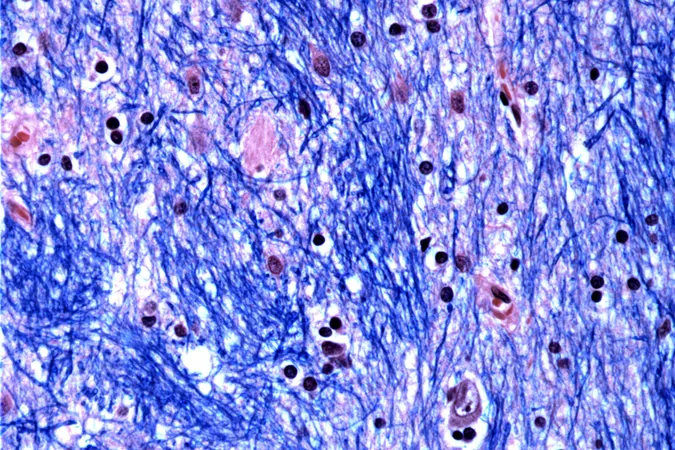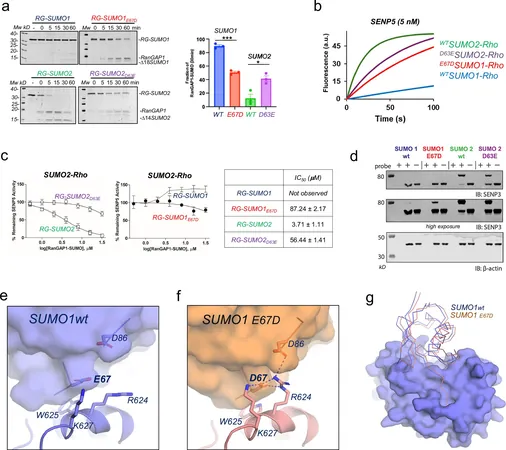
Groundbreaking Research Unveils the Hidden Triggers of Huntington's Disease
2025-01-19
Author: Mei
Introduction
Scientists are breaking new ground in understanding what triggers Huntington's disease, a genetic disorder that devastates lives and leads to death, often striking individuals in the prime of their lives. This hereditary condition causes the gradual breakdown and death of nerve cells, leading to severe dysfunctions in movement, cognition, and behavioral health.
Understanding the Mutation
While the genetic mutation responsible for Huntington's has been known for years, the mystery of why individuals carrying the mutation often do not display symptoms until later in life has perplexed researchers. A recent revolutionary study reveals that the mutation is initially harmless, lying dormant for decades before escalating into a harmful variant that produces toxic proteins leading to neuronal death.
Key Findings
Dr. Mark Mehler, director of the Institute for Brain Disorders and Neural Regeneration at Albert Einstein College of Medicine, described the findings as "landmark," emphasizing their potential to address longstanding questions within the scientific community. The anticipated breakdown of brain cells typically begins between the ages of 30 and 50, resulting in symptoms such as involuntary movements, an unsteady gait, personality changes, and impaired judgment, with deterioration taking 10 to 25 years.
Research Methodology
Researchers from the Broad Institute of MIT and Harvard, alongside colleagues from McLean Hospital and Harvard Medical School, conducted an in-depth analysis of brain tissue from 53 Huntington's patients and 50 healthy individuals, examining over half a million cells. They centered their investigation on a specific genetic alteration that involves a segment of DNA known for repeating a three-letter sequence—CAG—at least 40 times, compared to 15-35 times in non-affected individuals.
CAG Repeats and Neuronal Degeneration
Crucially, the researchers discovered that these CAG repeats expand over time, sometimes accumulating to hundreds of repetitions. They determined that when the count reaches approximately 150 CAGs, specific neurons begin to degenerate.
Implications of Research
The study’s co-senior author, Steve McCarroll, expressed surprise at the findings, indicating that the expansion of repeat tracts accelerates significantly after reaching 80 CAGs, leading to symptoms manifesting earlier in affected individuals.
Shifting Paradigms
Despite initial skepticism from parts of the scientific community—where previous beliefs indicated that expansions of 30 to 100 CAGs were needed to potentially trigger the disease—McCarroll clarified that while under 100 CAGs may not cause Huntington's, levels exceeding 150 CAGs certainly can.
Future Directions
The implications of this research are monumental. With approximately 41,000 Americans currently living with Huntington's, there remains no cure, with treatments focused primarily on managing symptoms. Recent experimental drugs aimed at diminishing the production of the malfunctioning protein have struggled to show efficacy, which researchers attribute to the rarity of neurons producing this toxic protein.
Hope for the Future
Anticipating future treatments, experts propose that strategies targeting the slowdown or cessation of CAG repeat expansions could hold the key to preventing or at least delaying the onset of the disease. McCarroll noted that many pharmaceutical companies are already ramping up efforts to explore these possibilities.
Conclusion
The journey to unravel the complexities of Huntington's disease continues, but this vital research could offer newfound hope for those affected and their families. Will innovative treatments be on the horizon as scientists sharpen their focus on this genetic enigma? Stay tuned for developments that could change lives!



 Brasil (PT)
Brasil (PT)
 Canada (EN)
Canada (EN)
 Chile (ES)
Chile (ES)
 Česko (CS)
Česko (CS)
 대한민국 (KO)
대한민국 (KO)
 España (ES)
España (ES)
 France (FR)
France (FR)
 Hong Kong (EN)
Hong Kong (EN)
 Italia (IT)
Italia (IT)
 日本 (JA)
日本 (JA)
 Magyarország (HU)
Magyarország (HU)
 Norge (NO)
Norge (NO)
 Polska (PL)
Polska (PL)
 Schweiz (DE)
Schweiz (DE)
 Singapore (EN)
Singapore (EN)
 Sverige (SV)
Sverige (SV)
 Suomi (FI)
Suomi (FI)
 Türkiye (TR)
Türkiye (TR)
 الإمارات العربية المتحدة (AR)
الإمارات العربية المتحدة (AR)